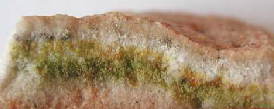|
Organisms thriving on Earth under extreme conditions
suggest that live could exist under similar conditions in other planets.
Cyanobacteria such as Chroococcidiopsis, from extremely hot and
cold deserts, provide unique models to gain an insight on the limits of
life on Earth and search extinct or extant life on other planets. In the
McMurdo Dry Valleys, Antarctica, Chroococcidiopsis finds refuge
in porous rocks and thus escapes the outside hostile climate, that makes
this environment the closest terrestrial analogue of Mars. The
capability of desert Chroococcidiopsis to survive extreme
desiccation (anhydrobiosis) and high doses of both ionizing (up to 15
KGy ) and ultraviolet (simulated Martian UV flux) radiation, makes it an
appropriate model-test in astrobiology.
|

Cryptoendolithic
growth of Chroococcidiopsis in a lichen-dominated microbial
community,
Ross
Desert (McMurdo Dry Valleys, Antarctica), kindly provided by E. Imre
Friedmann
|
|
Involved
scientists: Daniela
Billi
Collaborations: I.Friedmann (NASA Ames Research Center, Space
Science Division, CA, USA), C. Cockell (Planetary and Space Science
Research Institute, Open University, Milton, UK), S. Onori (UniversitÓ
della Tuscia, Viterbo).
Publications
|
